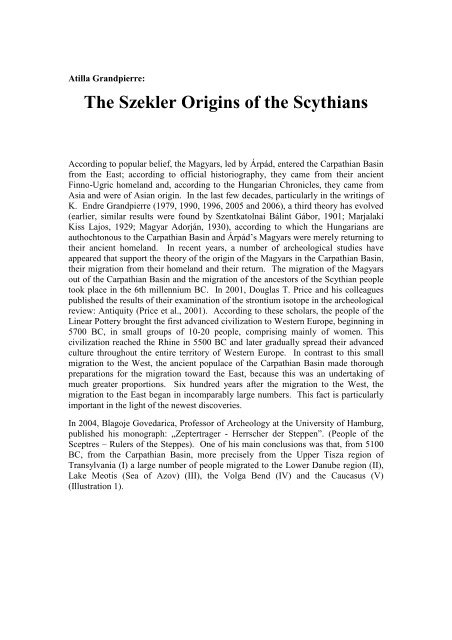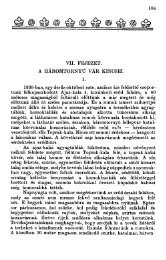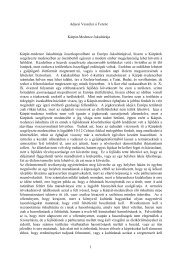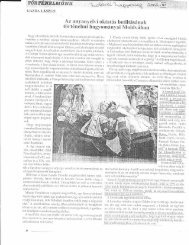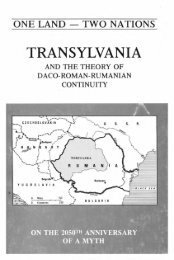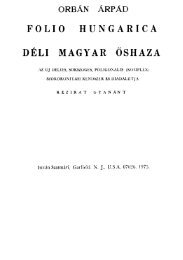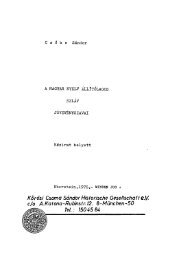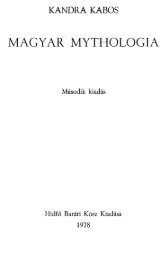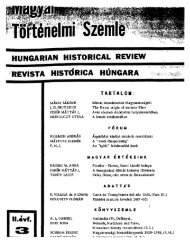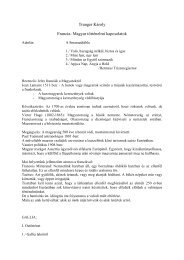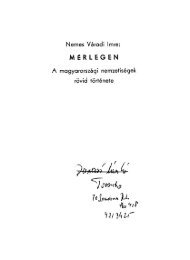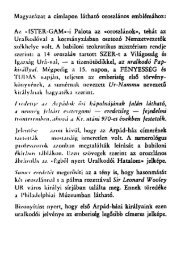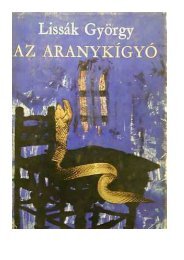The Szekler Origins of the Scythians
The Szekler Origins of the Scythians
The Szekler Origins of the Scythians
Create successful ePaper yourself
Turn your PDF publications into a flip-book with our unique Google optimized e-Paper software.
Atilla Grandpierre:<br />
<strong>The</strong> <strong>Szekler</strong> <strong>Origins</strong> <strong>of</strong> <strong>the</strong> <strong>Scythians</strong><br />
According to popular belief, <strong>the</strong> Magyars, led by Árpád, entered <strong>the</strong> Carpathian Basin<br />
from <strong>the</strong> East; according to <strong>of</strong>ficial historiography, <strong>the</strong>y came from <strong>the</strong>ir ancient<br />
Finno-Ugric homeland and, according to <strong>the</strong> Hungarian Chronicles, <strong>the</strong>y came from<br />
Asia and were <strong>of</strong> Asian origin. In <strong>the</strong> last few decades, particularly in <strong>the</strong> writings <strong>of</strong><br />
K. Endre Grandpierre (1979, 1990, 1996, 2005 and 2006), a third <strong>the</strong>ory has evolved<br />
(earlier, similar results were found by Szentkatolnai Bálint Gábor, 1901; Marjalaki<br />
Kiss Lajos, 1929; Magyar Adorján, 1930), according to which <strong>the</strong> Hungarians are<br />
authochtonous to <strong>the</strong> Carpathian Basin and Árpád’s Magyars were merely returning to<br />
<strong>the</strong>ir ancient homeland. In recent years, a number <strong>of</strong> archeological studies have<br />
appeared that support <strong>the</strong> <strong>the</strong>ory <strong>of</strong> <strong>the</strong> origin <strong>of</strong> <strong>the</strong> Magyars in <strong>the</strong> Carpathian Basin,<br />
<strong>the</strong>ir migration from <strong>the</strong>ir homeland and <strong>the</strong>ir return. <strong>The</strong> migration <strong>of</strong> <strong>the</strong> Magyars<br />
out <strong>of</strong> <strong>the</strong> Carpathian Basin and <strong>the</strong> migration <strong>of</strong> <strong>the</strong> ancestors <strong>of</strong> <strong>the</strong> Scythian people<br />
took place in <strong>the</strong> 6th millennium BC. In 2001, Douglas T. Price and his colleagues<br />
published <strong>the</strong> results <strong>of</strong> <strong>the</strong>ir examination <strong>of</strong> <strong>the</strong> strontium isotope in <strong>the</strong> archeological<br />
review: Antiquity (Price et al., 2001). According to <strong>the</strong>se scholars, <strong>the</strong> people <strong>of</strong> <strong>the</strong><br />
Linear Pottery brought <strong>the</strong> first advanced civilization to Western Europe, beginning in<br />
5700 BC, in small groups <strong>of</strong> 10-20 people, comprising mainly <strong>of</strong> women. This<br />
civilization reached <strong>the</strong> Rhine in 5500 BC and later gradually spread <strong>the</strong>ir advanced<br />
culture throughout <strong>the</strong> entire territory <strong>of</strong> Western Europe. In contrast to this small<br />
migration to <strong>the</strong> West, <strong>the</strong> ancient populace <strong>of</strong> <strong>the</strong> Carpathian Basin made thorough<br />
preparations for <strong>the</strong> migration toward <strong>the</strong> East, because this was an undertaking <strong>of</strong><br />
much greater proportions. Six hundred years after <strong>the</strong> migration to <strong>the</strong> West, <strong>the</strong><br />
migration to <strong>the</strong> East began in incomparably large numbers. This fact is particularly<br />
important in <strong>the</strong> light <strong>of</strong> <strong>the</strong> newest discoveries.<br />
In 2004, Blagoje Govedarica, Pr<strong>of</strong>essor <strong>of</strong> Archeology at <strong>the</strong> University <strong>of</strong> Hamburg,<br />
published his monograph: „Zeptertrager - Herrscher der Steppen”. (People <strong>of</strong> <strong>the</strong><br />
Sceptres – Rulers <strong>of</strong> <strong>the</strong> Steppes). One <strong>of</strong> his main conclusions was that, from 5100<br />
BC, from <strong>the</strong> Carpathian Basin, more precisely from <strong>the</strong> Upper Tisza region <strong>of</strong><br />
Transylvania (I) a large number <strong>of</strong> people migrated to <strong>the</strong> Lower Danube region (II),<br />
Lake Meotis (Sea <strong>of</strong> Azov) (III), <strong>the</strong> Volga Bend (IV) and <strong>the</strong> Caucasus (V)<br />
(Illustration 1).
Illustration 1. <strong>The</strong> Transylvanian Civilization (I), <strong>the</strong> migration <strong>of</strong> <strong>the</strong> People <strong>of</strong> <strong>the</strong><br />
Sceptres to <strong>the</strong> Eurasian Plain from 5100 BC.<br />
For millennia <strong>the</strong>se five centers <strong>of</strong> civilization influenced <strong>the</strong> development <strong>of</strong> Eurasia.<br />
<strong>The</strong>se mass migrations, which began in 5100 BC, must have involved a population <strong>of</strong><br />
millions, since we are talking <strong>of</strong> several thousands <strong>of</strong> settlements with an average<br />
population <strong>of</strong> several hundred to several thousand people. Igor Manzura, a Russian<br />
archeologist, published <strong>the</strong> results <strong>of</strong> his research in <strong>the</strong> Oxford Journal <strong>of</strong> Archeology<br />
in 2005 (Manzura, 2005), according to which, from <strong>the</strong> fifth millennium BC, large<br />
numbers <strong>of</strong> people migrated from Transylvania far<strong>the</strong>r and far<strong>the</strong>r toward <strong>the</strong> East in<br />
waves <strong>of</strong> settlements that <strong>the</strong>y established in <strong>the</strong> western Eurasian Plain. <strong>The</strong><br />
following question comes to mind: Why did <strong>the</strong> inhabitants <strong>of</strong> <strong>the</strong> Carpathian Basin at<br />
that time decide to send only small groups toward <strong>the</strong> West, whereas <strong>the</strong>y migrated to<br />
<strong>the</strong> East in huge numbers<br />
<strong>The</strong> answer to this question first came to me when I realized that a similar situation<br />
occurred in AD 1492, when <strong>the</strong> Hungarian King Ulászló II sanctioned <strong>the</strong> until <strong>the</strong>n<br />
unwritten, ancient law <strong>of</strong> <strong>the</strong> <strong>Szekler</strong>s that stated that <strong>the</strong> <strong>Szekler</strong>s were permitted to<br />
be conscripted in <strong>the</strong> case <strong>of</strong> a war but only one out <strong>of</strong> ten was to be called to serve<br />
against <strong>the</strong> West, whereas every o<strong>the</strong>r man could be called to serve as a soldier<br />
against <strong>the</strong> East. At first glance, it appeared surprising that, according to <strong>the</strong> ancient<br />
unwritten law <strong>of</strong> <strong>the</strong> <strong>Szekler</strong>s, it was not all <strong>the</strong> same to <strong>the</strong>m on which battleground<br />
<strong>the</strong>y had to risk <strong>the</strong>ir lives. I found <strong>the</strong> explanation to this phenomenon in <strong>the</strong> fact<br />
that <strong>the</strong>re is a zone in <strong>the</strong> eastern Carpathian Basin that is part <strong>of</strong> <strong>the</strong> plant and animal<br />
life <strong>of</strong> <strong>of</strong> <strong>the</strong> Eurasian Plain. (Illustration 2) <strong>The</strong> living conditions indicate that a<br />
similar connection has existed for millions <strong>of</strong> years, making it conceivable that not<br />
only <strong>the</strong> plant and animal kingdom <strong>of</strong> <strong>the</strong> ancient Carpathian Basin spread eastwards,<br />
but also Homo Sapiens, on a timescale <strong>of</strong> millions <strong>of</strong> years. <strong>The</strong>refore, it is almost<br />
certain that, during <strong>the</strong> time <strong>of</strong> <strong>the</strong> migration <strong>of</strong> peoples, <strong>the</strong> ancient people <strong>of</strong> <strong>the</strong><br />
Carpathian Basin initially chose to migrate toward <strong>the</strong> East.
Illustration 2. <strong>The</strong> Eurasian Plain stretches from <strong>the</strong> Carpathian Basin to <strong>the</strong> Pacific<br />
Ocean<br />
<strong>The</strong>re is evidence <strong>of</strong> migrations <strong>of</strong> people out <strong>of</strong> <strong>the</strong> Carpathian Basin from <strong>the</strong> time<br />
<strong>of</strong> Rudapi<strong>the</strong>cus to <strong>the</strong> Gravettian Culture. (Grandpierre, 2010) Thus <strong>the</strong> descendants<br />
<strong>of</strong> <strong>the</strong> ancient people <strong>of</strong> <strong>the</strong> Carpathian Basin, who honored <strong>the</strong>ir ancestors and <strong>the</strong><br />
land <strong>of</strong> <strong>the</strong>ir ancestors, initially migrated to <strong>the</strong> East in order to ensure <strong>the</strong><br />
continuation <strong>of</strong> <strong>the</strong>ir race. <strong>The</strong> ancient unwritten law <strong>of</strong> <strong>the</strong> <strong>Szekler</strong> people must also<br />
have originated from <strong>the</strong>ir ancient customs; this places <strong>the</strong> ancient origins <strong>of</strong> <strong>the</strong><br />
<strong>Szekler</strong>s in a new perspective. If this conclusion is supported by additional new facts<br />
(see Orbán-Grandpierre, 2009), <strong>the</strong>n <strong>the</strong> people, who received <strong>the</strong> name <strong>Scythians</strong><br />
from <strong>the</strong> Greeks only in <strong>the</strong> first millennium BC, were descendants <strong>of</strong> <strong>the</strong> ancient<br />
<strong>Szekler</strong>s, who lived in Transylvania in <strong>the</strong> sixth millennium BC. This startling<br />
conclusion is supported by a whole list <strong>of</strong> significant facts. We shall mention some <strong>of</strong><br />
<strong>the</strong>m.<br />
K. Endre Grandpierre (1996a, 22-36) and, following him, Dezső Orbán (Orbán,<br />
Grandpierre, 2009, 29-37) has shown that <strong>the</strong> names Székely and Szkíta are two<br />
variants <strong>of</strong> <strong>the</strong> same name. Fur<strong>the</strong>rmore K. Endre Grandpierre deduced that <strong>the</strong><br />
<strong>Szekler</strong>s and <strong>the</strong> <strong>Scythians</strong> were <strong>the</strong> same people (1996a, 29 and <strong>the</strong> following pages).<br />
If this identification indicates <strong>the</strong> <strong>Szekler</strong> origin <strong>of</strong> <strong>the</strong> <strong>Scythians</strong>, <strong>the</strong>n this calls for<br />
one <strong>of</strong> <strong>the</strong> greatest turnarounds in <strong>the</strong> writing <strong>of</strong> <strong>the</strong> history <strong>of</strong> <strong>the</strong> Hungarians.<br />
It is noteworthy that Govedarica calls <strong>the</strong> „People <strong>of</strong> <strong>the</strong> Sceptres” <strong>the</strong> „Rulers <strong>of</strong> <strong>the</strong><br />
Steppes”. <strong>The</strong> sceptre is without doubt a symbol <strong>of</strong> royalty; <strong>the</strong>refore <strong>the</strong> „People <strong>of</strong><br />
<strong>the</strong> Sceptres” were a royal people. How numerous could this royal people have been<br />
Manzura has recorded data about more than 800 settlements. <strong>The</strong> average number <strong>of</strong>
inhabitants was between 30 and 1000. At <strong>the</strong> time and place in question, <strong>the</strong> people<br />
occupied several thousand settlements, <strong>the</strong>refore <strong>the</strong> population must have been<br />
several hundred thousand, even millions, in <strong>the</strong> fifth millennium BC. <strong>The</strong>ir new<br />
environment encouraged enormous growth, evidenced by <strong>the</strong> construction <strong>of</strong> <strong>the</strong> royal<br />
kurgans (see below). <strong>The</strong> culture <strong>of</strong> <strong>the</strong> „People <strong>of</strong> <strong>the</strong> Sceptres” lasted for 3000<br />
years and was followed by <strong>the</strong> pre-Cimmerian culture (Timber-grave culture, Srubna<br />
culture) and <strong>the</strong> pre-Scythian culture (Andronovo culture) (Illustration 3.) in <strong>the</strong> huge<br />
territory between <strong>the</strong> Carpathian Basin and Korea (Govedarica, 2004).<br />
Illustration 3. <strong>The</strong> territory <strong>of</strong> <strong>the</strong> Srubna people (Timber-grave culture, pre-<br />
Cimmerians) and <strong>the</strong> Andronovo people (pre-<strong>Scythians</strong> or Magyars) in <strong>the</strong> entire<br />
Eurasian Plain about 1900 BC.<br />
In <strong>the</strong> first half <strong>of</strong> <strong>the</strong> first millennium BC, <strong>the</strong> Cimmerians, <strong>Scythians</strong> and, in <strong>the</strong><br />
East, <strong>the</strong> Huns, ruled <strong>the</strong> entire Eurasian Plain. According to every indication, <strong>the</strong>se<br />
three names referred to <strong>the</strong> same people. According to Herodotus, at <strong>the</strong> beginning <strong>of</strong><br />
<strong>the</strong> first millennium, <strong>the</strong> Royal tribe <strong>of</strong> <strong>the</strong> Cimmerians and <strong>the</strong> people <strong>of</strong> <strong>the</strong> Western<br />
Eurasian Plain, who co-existed with <strong>the</strong> Royal Cimmerians, were equipped with<br />
similar military strength. (We should note that in <strong>the</strong> Hungarian translation <strong>of</strong><br />
Herodotus: <strong>The</strong> Greco-Persian War, Volume IV, § 11, 1989, p. 269, <strong>the</strong> English word<br />
„natives”, meaning authochtonous, indigenous people, was translated as<br />
„Cimmerians” and thus <strong>the</strong> original meaning <strong>of</strong> „authochtonous or indigenous” was<br />
lost.) Thus <strong>the</strong> population <strong>of</strong> <strong>the</strong> Royal Cimmerians and <strong>the</strong> population <strong>of</strong> <strong>the</strong> people<br />
who had been living on <strong>the</strong> Western Eurasian Plain for millennia should be<br />
considered as populations <strong>of</strong> a comparable number. Moreover, this royal people had a<br />
high level <strong>of</strong> culture and were extraordinarily rich in knowledge and wealth.<br />
Govedarica noted that <strong>the</strong> people in territory (I), (II), (III), (IV) and those in territory<br />
(V), at least from 5 100 BC, were closely connected to one ano<strong>the</strong>r. This means that,<br />
throughout several millennia and across thousands <strong>of</strong> kilometers, <strong>the</strong>se people were
able to maintain <strong>the</strong>ir unified organization; in o<strong>the</strong>r words, <strong>the</strong>y were endowed with<br />
an unusual ability to organize a state. This remarkable ability for state organization<br />
was a special characteristic <strong>of</strong> <strong>the</strong> „Magi” or wise-men in ancient times, just as <strong>the</strong><br />
high level <strong>of</strong> culture, <strong>the</strong> respect for women and <strong>the</strong> remarkable level <strong>of</strong> knowledge<br />
possessed by <strong>the</strong> women. <strong>The</strong> combination <strong>of</strong> <strong>the</strong>se characteristics indicates that, in<br />
<strong>the</strong> millennia before Christ, <strong>the</strong> Carpathian Basin was <strong>the</strong> center <strong>of</strong> <strong>the</strong> Magi, and also<br />
that it was <strong>the</strong> ancient homeland <strong>of</strong> <strong>the</strong> peoples <strong>of</strong> <strong>the</strong> Eurasian Plains.<br />
Archeologists generally name <strong>the</strong> culture <strong>of</strong> an ancient people after <strong>the</strong> style <strong>of</strong> <strong>the</strong>ir<br />
pottery, <strong>the</strong>ir burial customs or <strong>the</strong> first important site <strong>of</strong> <strong>the</strong>ir finds. This people,<br />
which Govedarica names <strong>the</strong> „People <strong>of</strong> <strong>the</strong> Sceptres” after <strong>the</strong>ir burial customs, most<br />
o<strong>the</strong>r researchers call <strong>the</strong> Erősd (Transylvania), Cucuteni (today: Moldova), or<br />
Trypillian (Tripolye today: Ukraine) culture, after <strong>the</strong> location <strong>of</strong> <strong>the</strong>ir finds. This<br />
Erősd-Cucuteni-Trypillian culture (Illustration 4.) is today considered to be <strong>the</strong> first<br />
European civilization (History <strong>of</strong> Europe, 2010).<br />
Illustration 4. Territory <strong>of</strong> <strong>the</strong> Erősd-Cucuteni-Trypillian Culture, 5500 – 2750 BC.<br />
This people possessed a well-developed writing system at <strong>the</strong> end <strong>of</strong> <strong>the</strong> 6th<br />
millennium (Tordos, Tatárlaka and Vinca) and this writing system <strong>of</strong> Old Europe<br />
(Coppens, 2011) spread from here to sou<strong>the</strong>ast Europe (Fehérné Walter, 1975,<br />
Volume 1. p. 37; map by Todorovic, Illustration 5).
Illustration 5. Todorovic map, illustrating <strong>the</strong> spread <strong>of</strong> <strong>the</strong> Ancient European script<br />
from 5500 BC.<br />
Natalia Taranec <strong>of</strong> <strong>the</strong> Sydney Powerhouse Museum, in her article that appeared in<br />
2005, notes (Taranec, 2005) that <strong>the</strong> descendants <strong>of</strong> <strong>the</strong> Cucuteni-Trypillian people,<br />
living in <strong>the</strong> western part <strong>of</strong> <strong>the</strong> Eurasian Plain from 5500 to 2400 BC, were <strong>the</strong><br />
<strong>Scythians</strong>. (Cucuteni-Trypillian Culture, 2010) <strong>The</strong>refore, if <strong>the</strong> people <strong>of</strong> <strong>the</strong><br />
Eurasian Plain were <strong>the</strong> descendants <strong>of</strong> <strong>the</strong> ancient inhabitants <strong>of</strong> <strong>the</strong> Carpathian<br />
Basin, <strong>the</strong>n <strong>the</strong> authochtonous people <strong>of</strong> <strong>the</strong> Carpathian Basin were <strong>the</strong> ancestors <strong>of</strong><br />
<strong>the</strong> <strong>Scythians</strong>. Since <strong>the</strong> <strong>Szekler</strong>s speak <strong>the</strong> Magyar (Hungarian) language and<br />
preserve <strong>the</strong> ancient traditions and customs <strong>of</strong> that ancient people, <strong>the</strong>n we must come<br />
to <strong>the</strong> conclusion that <strong>the</strong> ancient people <strong>of</strong> <strong>the</strong> Carpathian Basin, <strong>the</strong> <strong>Scythians</strong> and<br />
<strong>the</strong> <strong>Szekler</strong>-Magyars, were all <strong>the</strong> same people, who received different names at<br />
different periods in history.<br />
<strong>The</strong>y possessed particular characteristics and <strong>the</strong>refore, from <strong>the</strong>ir burial customs,<br />
<strong>the</strong>y also received <strong>the</strong> name Kurgan or Tumulus Culture. Tumulus burials were<br />
common from <strong>the</strong> fifth millennium BC to <strong>the</strong> beginning <strong>of</strong> <strong>the</strong> second millennum AD,<br />
primarily in <strong>the</strong> Eurasian Plain that spread from <strong>the</strong> Carpathian Basin to Korea.
Archeologists divide this huge time-span into smaller sections. In chronological<br />
order, <strong>the</strong>y are <strong>the</strong> following: <strong>the</strong> Sredny Stog culture that is connected to <strong>the</strong><br />
Cucuteni-Trypillian culture (this includes <strong>the</strong> birth <strong>of</strong> <strong>the</strong> equestrian culture in <strong>the</strong> 5th<br />
millennium), <strong>the</strong> Pit-Grave, Timber-Grave, Scythian, Sarmatian, Hun and Kuman-<br />
Kipchak cultures. If <strong>the</strong> construction <strong>of</strong> kurgans can be attributed to one particular<br />
people, <strong>the</strong>n this people is <strong>the</strong> Scythian-Sarmatian-Hun-Kuman-Kipchak people.<br />
Moreover, archeologists have counted 40,000 kurgans in <strong>the</strong> Great Hungarian Plain.<br />
<strong>The</strong> Kurgan people possessed remarkable knowledge, a superior intellect, and<br />
technical, cultural and material wealth. For example, around <strong>the</strong> period from 3500 to<br />
3300 BC, <strong>the</strong>y began to construct splendid, rich, obviously royal kurgans in <strong>the</strong><br />
forested plain <strong>of</strong> <strong>the</strong> region <strong>of</strong> Kubán, which lies at <strong>the</strong> foot <strong>of</strong> <strong>the</strong> nor<strong>the</strong>rn slopes <strong>of</strong><br />
<strong>the</strong> Caucasus. Stone pillars surrounded <strong>the</strong> huge kurgans that had secret chambers<br />
deep within <strong>the</strong>m, filled with treasures. In <strong>the</strong> chambers, 70-liter cauldrons were also<br />
found, which came from <strong>the</strong> Caucasus, made with bronze containing arsenic; beside<br />
<strong>the</strong>m were vases made <strong>of</strong> gold and silver-plate, decorated with images <strong>of</strong> animals,<br />
silver rods decorated with golden bulls, bronze battle-axes and daggers and several<br />
hundred tools <strong>of</strong> gold, turquoise and chalcedony. (Anthony, 2007) Cauldrons are<br />
recognized as typical utensils <strong>of</strong> <strong>the</strong> Scythian, Hun and Magyar peoples. (Illustration<br />
6. Hun cauldron from Törtel)
Illustration 6. Hun cauldron from Törtel, ca. 400 AD.<br />
Archeologists label certain peoples after <strong>the</strong> characteristics <strong>of</strong> <strong>the</strong>ir artifacts, <strong>the</strong>refore<br />
<strong>the</strong>y regularly limit certain people and artifacts to increasingly narrower time-periods<br />
and territories. (Grandpierre K. Endre – Grandpierre Atilla, 2006) It is obvious that<br />
<strong>the</strong> Hungarian people <strong>of</strong> today use different utensils than people used a hundred or a<br />
thousand years ago, yet we are still talking <strong>of</strong> <strong>the</strong> same people. Similarly, <strong>the</strong><br />
historical names <strong>of</strong> peoples are <strong>of</strong>ten limited, particularly in <strong>the</strong> case <strong>of</strong> an ancient<br />
people living in a large territory over a long period, because those people, in different<br />
time-periods, were organized in different ways, and <strong>the</strong> neighboring peoples called<br />
<strong>the</strong>m by different names. Moreover, a certain people might have several important<br />
characteristics and only one <strong>of</strong> <strong>the</strong>m is emphasized when <strong>the</strong> people is named. <strong>The</strong>
People <strong>of</strong> <strong>the</strong> Sceptres (Govedarica, 2004) lived in <strong>the</strong> exact same time-period (5100 -<br />
2400 BC) in <strong>the</strong> exact same territory (<strong>the</strong> Carpathian Basin and <strong>the</strong> Eurasian Plain)<br />
and displayed <strong>the</strong> exact same characteristics as <strong>the</strong> people <strong>of</strong> <strong>the</strong> Erösd-Cucuteni-<br />
Trypillian culture (Cucuteni-Trypillian culture, 2010), and <strong>the</strong> people <strong>of</strong> <strong>the</strong> Kurgan<br />
culture (Kurgan Culture, 2000); <strong>the</strong>refore, <strong>the</strong>se three names actually refer to <strong>the</strong><br />
exact same people. Is it possible among <strong>the</strong>se separate peoples, recognized by<br />
historians, to identify whose ancestors we are talking about Let us try to examine<br />
this question independently <strong>of</strong> <strong>the</strong> already mentioned facts. To do this we shall<br />
examine a different archeological characteristic – <strong>the</strong> huge cauldrons that are a<br />
distinguishing characteristic <strong>of</strong> <strong>the</strong> Huns (Bóna-Cseh-Nagy et al, 1993). It is<br />
interesting that, in <strong>the</strong> English Wikipedia, in <strong>the</strong> entry entitled: „Cauldron”, <strong>the</strong>re is a<br />
picture <strong>of</strong> a Hungarian „bogrács”, (Cauldron, 2010). Scythian cauldrons have also<br />
been found in Transylvania (Illustration 7).<br />
Illustration 7. Scythian cauldron from Transylvania, ca. 600 BC<br />
<strong>The</strong> Kurgan people also produced huge cauldrons (Sylvia, 2000) and this indicates<br />
that <strong>the</strong> descendants <strong>of</strong> <strong>the</strong> Kurgan people were <strong>the</strong> Huns. From <strong>the</strong> depths <strong>of</strong> <strong>the</strong><br />
huge Issyk Kul Lake, which lies at <strong>the</strong> foot <strong>of</strong> <strong>the</strong> nor<strong>the</strong>rn slopes <strong>of</strong> <strong>the</strong> Tien-San<br />
Mountain Range, (today Kyrgyzstan), archeologists unear<strong>the</strong>d a huge cauldron, 2 500<br />
years old, which was an amazing work <strong>of</strong> craftsmanship. According to <strong>the</strong> experts <strong>the</strong><br />
separate parts fit toge<strong>the</strong>r with such precision that could be achieved today only by
working <strong>the</strong> metal in an inert gas. It is a riddle how <strong>the</strong> two Royal Szaka-Scythian<br />
peoples, who lived here for more than 5 000 years were able to achieve such a high<br />
level <strong>of</strong> technological perfection. Of particularly high quality are <strong>the</strong> bronze mirrors,<br />
<strong>the</strong> ornamented horse equipment and many o<strong>the</strong>r objects. Under <strong>the</strong> water, <strong>the</strong>y<br />
found small gold wire-rings and large six-sided nuggets <strong>of</strong> gold (Lukashov, 2008).<br />
This civilization was <strong>of</strong> at least <strong>of</strong> equal rank to <strong>the</strong> recognized highest level<br />
civilizations <strong>of</strong> old, <strong>the</strong> Greek and <strong>the</strong> Egyptian. <strong>The</strong> clothing <strong>of</strong> <strong>the</strong> Royal Szaka-<br />
<strong>Scythians</strong> also displayed extraordinary craftsmanship and wealth. (Illustration 8) We<br />
may add that, according to <strong>the</strong> most recent anthropological research, <strong>the</strong><br />
characteristics <strong>of</strong> <strong>the</strong> skulls <strong>of</strong> <strong>the</strong> Timber-grave culture were identical to those <strong>of</strong> <strong>the</strong><br />
<strong>Scythians</strong>, who succeeded <strong>the</strong>m in that territory (Dolukhanov, 1996).<br />
Illustration 8. Golden Szaka. Reconstructed ancient <strong>Szekler</strong>-Szaka costume from 500<br />
BC. Found in <strong>the</strong> Issyk Kul kurgan.<br />
Huns who arrived in <strong>the</strong> region <strong>of</strong> Ordos in <strong>the</strong> 8th to <strong>the</strong> 6th century BC, were called<br />
<strong>Scythians</strong> by <strong>the</strong> ancient Greeks (Gilbert, 2002, map 2; illustration 9); <strong>the</strong>refore, both<br />
names indicate <strong>the</strong> same people at that same time-period.
Illustration 9. <strong>The</strong> Huns that migrated from East to West into Hungary were called<br />
<strong>Scythians</strong> by <strong>the</strong> Greeks. (Martin Gilbert, 2002)
It is interesting, for example, that <strong>the</strong> <strong>Scythians</strong> arrived on <strong>the</strong> island <strong>of</strong> Cyprus in <strong>the</strong><br />
8th century BC. In <strong>the</strong>ir tracks, <strong>the</strong>y left a flourishing society, with royal graves<br />
which, although <strong>the</strong>y have been plundered, still dazzle us with <strong>the</strong>ir royal opulence.<br />
Traces <strong>of</strong> horse sacrifice, bronze trestles, huge cauldrons decorated with sirens and<br />
griffins, ornamental carts, horse equipment, ivory beads and thrones decorated with<br />
unparalleled elegance are all witness to <strong>the</strong>ir high level <strong>of</strong> civilization (Prehistoric<br />
Cyprus, 2010).<br />
No doubt, those ancient place-names, which have not been changed by <strong>the</strong> linguistic<br />
imperialism <strong>of</strong> <strong>the</strong> conquering states driven by bias, can be counted as certain pro<strong>of</strong> <strong>of</strong><br />
<strong>the</strong> presence or absence <strong>of</strong> one or ano<strong>the</strong>r people (Grandpierre K. Endre, 1996). <strong>The</strong><br />
examination <strong>of</strong> <strong>the</strong> Eurasian place-names supports <strong>the</strong> <strong>the</strong>ory <strong>of</strong> <strong>the</strong> Transylvanian-<br />
<strong>Szekler</strong> origin <strong>of</strong> <strong>the</strong> settlements <strong>of</strong> <strong>the</strong> Eurasian Plains. (Bihari, 2004) Herodotus<br />
writes that <strong>the</strong> <strong>Scythians</strong> called <strong>the</strong>mselves: „Szkolota” or, if we remove <strong>the</strong> –ta suffix<br />
indicating <strong>the</strong> name <strong>of</strong> a people, we will arrive at <strong>the</strong> „Szkol, Szikul, Székely” people<br />
name. <strong>The</strong> computer examination <strong>of</strong> <strong>the</strong> several hundred million place-names<br />
indicates that variations <strong>of</strong> <strong>the</strong> place-name „sz*k*(l)” (here <strong>the</strong> * indicates <strong>the</strong><br />
possible vowel) are found most <strong>of</strong>ten in Transylvania and Moldova, in <strong>the</strong> Carpathian<br />
Basin and <strong>the</strong>n in Eurasia. In <strong>the</strong> wider search <strong>of</strong> all <strong>of</strong> Eurasia, <strong>the</strong> Transylvanian<br />
place-names come up in large numbers. Bihari writes (op. cit. p. 91) that, according<br />
to <strong>the</strong> witness <strong>of</strong> <strong>the</strong> place-names, <strong>the</strong> <strong>Szekler</strong> names are none o<strong>the</strong>r than <strong>the</strong> modern<br />
version <strong>of</strong> <strong>the</strong> ancient Szaka names. However, <strong>the</strong> above-mentioned facts would lead<br />
us to conclude that <strong>the</strong> situation is <strong>the</strong> reverse: <strong>the</strong> <strong>Szekler</strong> names are <strong>the</strong> older<br />
versions.<br />
According to our examination, <strong>the</strong> <strong>Scythians</strong> are <strong>of</strong> <strong>Szekler</strong>-Magyar origin. From 5<br />
100 BC to <strong>the</strong> time <strong>of</strong> <strong>the</strong> ancient Greeks, <strong>the</strong>ir population must have multiplied many<br />
times. In that geographical territory in which <strong>the</strong>y lived for millennia, from 5 100 BC<br />
to AD 453, to <strong>the</strong> time <strong>of</strong> Atilla’s assassination, <strong>the</strong>y spread from <strong>the</strong> Carpathian<br />
Basin to Korea and Nor<strong>the</strong>rn India (Grandpierre K. Endre – Grandpierre Atilla, 2006;<br />
Grandpierre, 2007; Aradi, 2005). This fact is supported by <strong>the</strong> observation that <strong>the</strong><br />
ancient historians considered <strong>the</strong> <strong>Scythians</strong> to be <strong>the</strong> most ancient people with <strong>the</strong><br />
largest population. „For if <strong>the</strong> <strong>Scythians</strong> were united, <strong>the</strong>re is no nation which would<br />
compare with <strong>the</strong>m; I do not say in Europe, but even in Asia...” (Thucydides, 431 BC,<br />
translated into English by Benjamin Jowett, Volume 1, 1881, Clarendon Press, Book<br />
II, §97, p. 163). Terdzsüman Mahmud, <strong>the</strong> scholarly Hungarian interpreter <strong>of</strong> Sultan<br />
Suleiman I, in his ancient chronicle <strong>of</strong> <strong>the</strong> time <strong>of</strong> King Árpád, written in Hungarian:<br />
<strong>the</strong> Tárih-i-Üngürüsz (History <strong>of</strong> <strong>the</strong> Magyars – <strong>the</strong> name „üngürüsz” was <strong>the</strong> name <strong>of</strong><br />
<strong>the</strong> Magyars in <strong>the</strong> Turkish language) similarly recalls <strong>the</strong> people found by Hunor in<br />
<strong>the</strong> Carpathian Basin in <strong>the</strong> time following <strong>the</strong> Deluge: Hunor, son <strong>of</strong> Nimrod – „left<br />
<strong>the</strong> Padisha <strong>of</strong> Adzsem (Persia) and, with his people, moved to <strong>the</strong> Province <strong>of</strong><br />
Pannonia. When <strong>the</strong>y arrived in this province, <strong>the</strong>y saw that <strong>the</strong>re was an abundance<br />
<strong>of</strong> fruit and grain in this country and, in <strong>the</strong>ir language (that is in <strong>the</strong> language <strong>of</strong> <strong>the</strong><br />
people <strong>of</strong> Hunor), <strong>the</strong>y were able to speak to <strong>the</strong> inhabitants.” <strong>The</strong> ancient chronicle,<br />
written by <strong>the</strong> bards (“regös”, in Hungarian) at that time (before 896 A.D.), proves<br />
that <strong>the</strong> „Üngürüsz” people were descendants <strong>of</strong> <strong>the</strong> people <strong>of</strong> Hunor.<br />
This is a perfectly clear line <strong>of</strong> reasoning that proves <strong>the</strong> thousand year-old antiquity<br />
<strong>of</strong> <strong>the</strong> ancient existence <strong>of</strong> <strong>the</strong> Magyar people, and it is a pro<strong>of</strong> that <strong>the</strong> Magyars were<br />
living in <strong>the</strong> Carpathian Basin in <strong>the</strong> time following <strong>the</strong> Deluge, and that <strong>the</strong>y
migrated from here in undetermined times to <strong>the</strong> o<strong>the</strong>r land <strong>of</strong> <strong>the</strong> <strong>Scythians</strong>, east <strong>of</strong><br />
Europe. Endre K. Grandpierre (1979, 1990) has shown that our legends <strong>of</strong> <strong>the</strong><br />
Wondrous Stag look back over several tens <strong>of</strong> thousands <strong>of</strong> years and bear witness to<br />
<strong>the</strong> return <strong>of</strong> <strong>the</strong> Magyars to <strong>the</strong>ir ancient home, <strong>the</strong> Carpathian Basin, according to<br />
<strong>the</strong> will <strong>of</strong> God.<br />
In agreement with Thucydides, Xenophon also writes that <strong>the</strong> <strong>Scythians</strong> ruled Europe:<br />
“in Europe we find <strong>the</strong> <strong>Scythians</strong> ruling, and <strong>the</strong> Maeotians being ruled.” (Xenophon,<br />
Memorabilia, Book Two, cca. 371 B.C.) This statement is fully supported by <strong>the</strong><br />
archeological finds (see <strong>the</strong> map <strong>of</strong> <strong>the</strong> Scythian archeological finds, Illustration 9).<br />
Illustration 10. <strong>The</strong> map <strong>of</strong> Scythian archeological findings, 1 st millenium B. C.<br />
<strong>The</strong> Scythian influence spread to Korea and Japan. Certain Korean artifacts, even<br />
some very important ones like <strong>the</strong> crown <strong>of</strong> <strong>the</strong> Korean Silla kingdom, show Scythian<br />
characteristics. Archeologists have found similar crowns with Scythian<br />
characteristics in <strong>the</strong> K<strong>of</strong>un period <strong>of</strong> Japan (AD 250-538, or <strong>the</strong> so-called Hun age<br />
(Cambon et al., 2006, 282). <strong>The</strong> Chinese took over from <strong>the</strong> <strong>Scythians</strong> <strong>the</strong> animal<br />
style (Mallory, Mair 2000). <strong>The</strong> influence <strong>of</strong> <strong>the</strong> Hun-Magyar folk music on <strong>the</strong><br />
Chinese folk music can be shown to be <strong>of</strong> great importance even today (Juhász,<br />
2005). In very ancient times, before <strong>the</strong> dawn <strong>of</strong> <strong>the</strong> Chinese religion, <strong>the</strong>re could<br />
have been organized parishes <strong>of</strong> <strong>the</strong> Magus religion (de Groot [1982, VI, II:1187]). In<br />
<strong>the</strong> millennia before Christ, <strong>the</strong> Magi played a leading role in <strong>the</strong> Chinese religion<br />
(Schafer [2005, 234]). Victor H. Mair, Pr<strong>of</strong>essor <strong>of</strong> <strong>the</strong> Chinese language and<br />
literature, found archeological and linguistic pro<strong>of</strong>s that <strong>the</strong> old-Chinese word<br />
„*myag” meaning magus, natural healer, philosopher, was not <strong>of</strong> Chinese but <strong>of</strong><br />
Central Asian origin (Mair [1990]).<br />
In China, <strong>the</strong> teachings <strong>of</strong> <strong>the</strong> Magi were primarily most important in <strong>the</strong> ancient royal<br />
religion. (Harper, 1995). <strong>The</strong> Chinese Universalism, Confucianism and Taoism were
uilt upon <strong>the</strong> teachings <strong>of</strong> <strong>the</strong> Magi. We learn from <strong>the</strong> book <strong>of</strong> Pr<strong>of</strong>essor Modi<br />
(Modi, 1926) and Eva Aradi (Aradi, 2005) that <strong>the</strong> Scythian-Magyar-Hun culture had<br />
a very basic influence on <strong>the</strong> history and civilization <strong>of</strong> India (Grandpierre, 2007).<br />
<strong>The</strong> authoritative historian, Josephus Flavius (AD 37) writes in his work: Antiquitates<br />
(Flavius, 1957, 59) that <strong>the</strong> people <strong>of</strong> Magog and Gomer, after <strong>the</strong> Deluge, went „as<br />
far as <strong>the</strong> Tanais (Don) River, and in <strong>the</strong> West as far as Gadeir (today Cadiz),<br />
occupying <strong>the</strong> land which <strong>the</strong>y came to and which before <strong>the</strong>m nobody had<br />
occupied, and in <strong>the</strong>ir own language, <strong>the</strong>y named <strong>the</strong> people. In his ancient legend<br />
about <strong>the</strong> <strong>Scythians</strong>, Herodotus notes that Hargita was <strong>the</strong> first man to be born in<br />
<strong>the</strong> „uninhabited territory”, in o<strong>the</strong>r words, Man appeared in <strong>the</strong> Carpathian Basin<br />
with <strong>the</strong> <strong>Scythians</strong>.<br />
In <strong>the</strong> Hungarian chronicles <strong>of</strong> <strong>the</strong> Middle Ages and in Hungarian folk traditions, is<br />
preserved <strong>the</strong> belief that <strong>the</strong> Magyars were at one time <strong>the</strong> most populous people <strong>of</strong><br />
<strong>the</strong> world. <strong>The</strong> ancient kings <strong>of</strong> <strong>the</strong> Magyars were <strong>the</strong> rulers <strong>of</strong> <strong>the</strong> four points <strong>of</strong> <strong>the</strong><br />
compass; <strong>the</strong>y organized <strong>the</strong> network <strong>of</strong> <strong>the</strong> guardians <strong>of</strong> <strong>the</strong> four points, including <strong>the</strong><br />
four rivers and <strong>the</strong> four sections <strong>of</strong> <strong>the</strong> coat <strong>of</strong> arms <strong>of</strong> <strong>the</strong> lion <strong>of</strong> Esztergom. <strong>The</strong><br />
affection for <strong>the</strong> ancient homeland is expressed in <strong>the</strong> Medieval slogan: „Extra<br />
Hungariam non est vita” (<strong>the</strong>re is no life except in Hungary) (Grandpierre K. Endre,<br />
1996). <strong>The</strong> several thousand year-old antiquity <strong>of</strong> <strong>the</strong> <strong>Szekler</strong>s in Transylvania has<br />
only recently come to light. (Orbán-Grandpierre, 2009).<br />
In <strong>the</strong> light <strong>of</strong> all this, it is time that we recognize that it is more appropriate, in place<br />
<strong>of</strong> <strong>the</strong> Scythian-Hun origin <strong>of</strong> <strong>the</strong> <strong>Szekler</strong> Hungarians, to speak <strong>of</strong> <strong>the</strong> <strong>Szekler</strong>-Magyar<br />
origin <strong>of</strong> <strong>the</strong> Scythian-Hun people.<br />
Published in: Letagadott eleink, a szkíták (Our Disavowed Forefa<strong>the</strong>rs, <strong>the</strong> <strong>Scythians</strong>) (Scythian<br />
Reader). Kisenciklopédia 3. Magyarságtudományi Füzetek. Edited by Pápai Szabó György. Hunidea,<br />
2010. 33-42.<br />
Bibliography<br />
Anthony, D. W. 2007, <strong>The</strong> Horse, <strong>the</strong> Wheel and Languages How Bronze-Age<br />
Riders from <strong>the</strong> Eurasian Steppes Shaped <strong>the</strong> Modern World. Princeton University<br />
Press.<br />
Aradi, Éva: A hunok Indiában, Hun Idea, Budapest, 2005. 152 (in Hungarian)<br />
Bihari, G. 2004, A népek országútján I. – Szkíták, szakák, székelyek – A nomád<br />
népvándorlások története. Szkíta Szarvas Könyvkiadó (in Hungarian).<br />
Bóna, I., Cseh, J., Nagy M., Tomka P., Tóth Á. 1993, Hunok-gepidák-langobardok.<br />
http://www.bkiado.hu/netre/netre_hungeplan/hungeplanjobb_metaval.htm#hun%C3%<br />
BCst<br />
Cauldron, 2010, http://en.wikipedia.org/wiki/Cauldron<br />
Coppens, P. 2011, Old Europe, http://www.philipcoppens.com/oldeurope.html
Cucuteni-Tripyllian culture, 2011, http://en.wikipedia.org/wiki/Cucuteni-<br />
Trypillian_culture<br />
Kurgan culture, 2000, http://www.iras.ucalgary.ca/~volk/sylvia/Kurgans.htm<br />
de Groot, J. J. M., 1982, <strong>The</strong> Religious System <strong>of</strong> China. Repr. Sou<strong>the</strong>rn Materials<br />
Center, Inc. Taipei, China, 1892-1920/1982. Vol. VI, Book II, 1187<br />
Dolukhanov, Pavel, 1996, <strong>The</strong> Early Slavs. Eastern Europe from <strong>the</strong> Initial Settlement<br />
to <strong>the</strong> Kievan Rus. Longman, p. 125 (& references <strong>the</strong>rin)<br />
Fehérné, Walter Anna: Ékírástól a Rovásíráisig, Buenos Aires, 1975. (In Hungarian)<br />
Flavius, Josephus, 1957, Jewish Antiquities I-IV. With an English translation by<br />
H. H. J. Thackeray, M. A., <strong>The</strong> Loeb Classical Library. In nine volumes, Cambridge,<br />
Massachusetts, Harvard Universitsy Press, 59.<br />
Govedarica, B. 2004, Zeptertrager: Herrscher der Steppe. Verlag Philipp von Zabern,<br />
Mainz am Rhein. Heidelberger Akademie der Wissenschaften, 21.<br />
Grandpierre, K. Endre: A csodaszarvas-monda új változatai egy latinból törökre<br />
fordított magyar ősgesztában. Kortárs XXIII. Évfolyam, December 1979, 12 szám,<br />
1952-1969.<br />
Grandpierre, K. Endre: Aranykincsek hulltak a Hargitára. A magyarok eredete a<br />
Tarih-i Üngürüsz tükrében. Népszava, Budapest. 1990<br />
Grandpierre, K. Endre: Mióta él nemzet e hazán Történelmünk Központi Titkai<br />
sorozat, 3. szám. 1996a.<br />
Grandpierre, K. Endre: Tízezer évi küzdelem hazánk megmaradásáért. Történelmünk<br />
Központi Titkai sorozat, 6. szám. 1996b.<br />
Grandpierre, K. Endre: A magyarság őseredete. Történelmünk Központi Titkai<br />
sorozat, 8. szám. 1996c.<br />
Grandpierre K. Endre: Isten szava a magyar nép szava.. Történelmünk Központi<br />
Titkai sorozat, 4. szám. 1996d.<br />
Grandpierre, K. Endre: Hol van a magyar őshaza Történelmünk Központi Titkai<br />
sorozat, 2. szám. 1996e.<br />
Grandpierre, K. Endre and Grandpierre Attila: Atilla és a hunok. A szkíta-hun-magyar<br />
folytonosság (Atilla and <strong>the</strong> Huns. <strong>The</strong> Scythian-Hun-Magyar continuity). NapKút<br />
Kiadó, Budapest 2006 (in Hungarian).<br />
Hérodotosz: A görög-perzsa háború, IV. Könyv, 11. §, 1989, 269.<br />
History <strong>of</strong> Europe, 2011. http://en.wikipedia.org/wiki/History_<strong>of</strong>_Europe
Juhász, Z. 2006, A zene ősnyelve. Fríg Kiadó (in Hungarian).<br />
Juhász, Z. 2007, Analysis <strong>of</strong> Melody Roots in Hungarian Folk Music Using Self-<br />
Organizing Maps with Adaptively Weighted Dynamic Time Warping. Applied<br />
Artificial Intelligence 21(1): 35-55.<br />
Juhász, Z. 2008, A Comparative Study <strong>of</strong> Interethnic Connections <strong>of</strong> Hungarian Folk<br />
Music in Eurasia using Artificial Intelligences.<br />
http://homepages.indiana.edu/web/page/normal/7872.html<br />
Juhász, Z. 2009, Hungarian Folk Music and Its Eurasian Relationships — Enquiry<br />
Based on Artificial Intelligence. Mikes International, 2009 October-December.<br />
Lukashov, N. 2008, Ancient Civilization Discovered at <strong>the</strong> Bottom <strong>of</strong> Lake Issyk Kul<br />
in <strong>the</strong> Kyrgyz Mountains.<br />
http://www.redicecreations.com/article.phpid=2626<br />
http://en.wikipedia.org/wiki/Prehistoric_Cyprus<br />
Magyar Adorján: Ázsiából jöttünk-e vagy európai ősnép vagyunk (Vác, 1930)<br />
Mair, Victor H.: Old Sinitic *Myag, Old Persian Magus and English Magician, Early<br />
China 1990, 15: 27–47.<br />
Martin Gilbert, 2002, <strong>The</strong> Routledge Atlas <strong>of</strong> Russian history. Routledge, London,<br />
map 2.<br />
Mallory, J. P. and Mair, V. H. 2000, <strong>The</strong> Tarim Mummies: Ancient China and <strong>the</strong><br />
Mystery <strong>of</strong> <strong>the</strong> Earliest Peoples from <strong>the</strong> West. Thames and Hudson.<br />
Manzura, I. 2005, Steps to <strong>the</strong> Steppe: or, how <strong>the</strong> North Pontic Region was<br />
Colonised, Oxford Journal <strong>of</strong> Arcaeology, 24 (4), 313-338.<br />
Marjalaki Kiss Lajos, 1929, Anonymus és a magyarság eredete. Miskolc, 1929.<br />
Orbán, D. and Grandpierre, A. 2009, Chapters from <strong>the</strong> History <strong>of</strong> Seklers. Karpatia<br />
Publishers (in Hungarian)<br />
Prehistoric Cyprus, 2010, http://en.wikipedia.org/wiki/Prehistoric_Cyprus<br />
Price, T. D., Bentley, R. A., Luning, J., Gronenborg, D., Wahl, J.: Prehistoric human<br />
migration in <strong>the</strong> Linearbandkeramik <strong>of</strong> Central Europe, Antiquity 75, 2001. 593-603.<br />
Price, T. D., Knipper, C., Grupe, G., Smrcka, V.: Strontium Isotopes and Prehistoric<br />
Human Migration: <strong>The</strong> Bell Beaker Period in Central Europe. European Journal <strong>of</strong><br />
Archeology, 2004. Vol. 7, No. 1, 9-40.<br />
Schafer, E. H.: Pacing <strong>the</strong> Void. T’ang Approaches to Stars. Floating World Edition,<br />
1977/2005. 234.<br />
Sylvia, 2000, http://www.iras.ucalgary.ca/~volk/sylvia/Kurgans.htm
Szentkatolnai Bálint Gábor, 1901, A honfoglalás revíziója. Kolozsvár.<br />
Taranec, N. 2005, <strong>The</strong> Trypilska Kultúra – <strong>The</strong> Spiritual Birthplace <strong>of</strong> Ukraine,<br />
www.trypilla.com/articles/eng/rec.shtml<br />
Xenophon, cca. 371 B. C. MEMORABILIA. IN FOUR WEBPAGE PARTS -<br />
WEBPAGE TWO- BOOK TWO. THE TRIAL OF SOCRATES. Translated by<br />
Benjamin Jowett (1817-1893),<br />
http://evans-experientialism.freewebspace.com/xenophon_memorabilia02.htm


